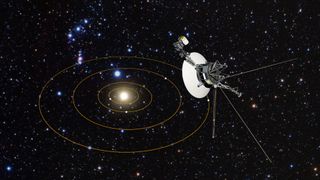
Artist’s illustration of Voyager 1 probe looking back at the solar system from a great distance.
(Image credit: NASA, ESA, and G. Bacon (STScI))
NASA’s Voyager 1 probe is currently unable to transmit any scientific or systems data back to Earth. The 46-year-old spacecraft is capable of receiving commands, but a problem seems to have arisen with the probe’s computers.
Voyager 1’s flight data system (FDS), which collects onboard engineering information and data from the spacecraft’s scientific instruments, is no longer communicating as expected with the probe’s telecommunications unit (TMU), according to a NASA blog post on Dec. 12.
When functioning properly, the FDS compiles the spacecraft’s info into a data package, which is then transmitted back to Earth using the TMU. Lately, that data package has been “stuck,” the blog post said, “transmitting a repeating pattern of ones and zeros.” Voyager’s engineering team traced the problem back to the FDS, but it could be weeks before a solution is found.
Related: NASA’s interstellar Voyager probes get software updates beamed from 12 billion miles away
Voyager 1, and its twin spacecraft Voyager 2, launched in 1977 and have been operational longer than any other spacecraft in history. Both are in interstellar space, speeding into the cosmos more than 15 billion miles (24 billion kilometers) from Earth.
They are so far away, in fact, that it takes nearly a day (22.5 hours) for a transmission to reach the spacecraft, and another day to receive any sort of response. A single back-and-forth communication with Voyager 1 takes 45 hours. So, whenever NASA engineers are able to send a fix for the probe’s FDS, they will have to wait until the following day to find out if it works.
And the solution won’t be as simple as just turning the system on and off again (they tried that — it didn’t work). The spacecraft’s age and hardware present a unique set of challenges. NASA technicians must work within the framework and technology available to their predecessors in the 1970s, sometimes forcing some creative software work-arounds.
This isn’t the first malfunction Voyager 1 has experienced in recent years. Issues with the probe’s attitude articulation and control system (AACS) were noticed in May 2022, and persisted transmitting nonsense telemetry data for several months before a workaround was found.
Another update came in October 2023, with a software patch to help ultimately solve that issue, and also prevent residue build-up on the probes’ thrusters. But these kinds of updates don’t come quickly. NASA’s blog clarifies, “finding solutions to challenges the probes encounter often entails consulting original, decades-old documents written by engineers who didn’t anticipate the issues that are arising today. As a result, it takes time for the team to understand how a new command will affect the spacecraft’s operations in order to avoid unintended consequences.”
Join our Space Forums to keep talking space on the latest missions, night sky and more! And if you have a news tip, correction or comment, let us know at: community@space.com.
Breaking space news, the latest updates on rocket launches, skywatching events and more!
Josh Dinner is Space.com’s Content Manager. He is a writer and photographer with a passion for science and space exploration, and has been working the space beat since 2016. Josh has covered the evolution of NASA’s commercial spaceflight partnerships, from early Dragon and Cygnus cargo missions to the ongoing development and launches of crewed missions from the Space Coast, as well as NASA science missions and more. He also enjoys building 1:144 scale models of rockets and human-flown spacecraft. Find some of Josh’s launch photography on Instagram and his website, and follow him on Twitter, where he mostly posts in haiku.
>>> Read full article>>>
Copyright for syndicated content belongs to the linked Source : Space.com – https://www.space.com/voyager-1-flight-data-system-glitch
